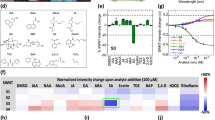Abstract
STORAGE at reduced atmospheric pressure and low temperature is used to retard the post-harvest senescence of fruits, vegetables, cut flowers, and cuttings1–3. The effect of this low pressure storage (LPS) has mainly been ascribed to reduction of the internal concentration of the senescence-accelerating gas ethylene4, although occasionally effects of a lowered partial oxygen tension() have also been reported5–7, to determine the contribution of the reduction in to the total effect of LPS on the retardation of post-harvest senescence, we studied the course of ripening of tomato fruits at different atmospheric and partial oxygen pressures, with and without absorbing the ethylene produced. We report that both the onset and the rate of the ripening process are determined by the oxygen pressure, irrespective of the atmospheric pressure and the absorption of endogenously evolved ethylene.
This is a preview of subscription content, access via your institution
Access options
Subscribe to this journal
Receive 51 print issues and online access
$199.00 per year
only $3.90 per issue
Buy this article
- Purchase on Springer Link
- Instant access to full article PDF
Prices may be subject to local taxes which are calculated during checkout
Similar content being viewed by others
References
Burg, S. P., and Burg, E. A., Science, 153, 314–315 (1966); Hortscience, 8, 202–205 (1973).
Bangerth, F., Gartenbauwissenschaft, 38, 479–508 (1973).
Wu, M. T., Jadhav, S. J., and Saluhkhe, D. K., J. Food Sci., 37, 952–956 (1972).
Burg, S. P., and Burg, E. A., Physiologia Pl., 18, 870–884 (1965).
Burg, S. P., and Burg, E. A., Qualitas Pl. Mater. veg., 19, 185–200 (1969).
Tolle, W. E., U. S. Dept. Agr. Mark. Res. Rep., 842, 1–9 (1969).
Salunkhe, D. K., and Wu, M. T., J. Am. Soc. hort. Sci., 98, 113–116 (1973).
Stenvers, N., Rudolphij, J. W., and Bruinsma, J., Gartenbauwissenschaft, 38, 517–531 (1974).
Knegt, E., Kramer, S. J., and Bruinsma, J., in Facteurs et Regulation de la Maturation des Fruits CNRS, Paris (in the press).
Eaves, C. A., Forsyth, F. R., Leefe, J. S., and Lockhart, C. L., Can. J. Pl. Sci., 44, 458–465 (1964).
Fidler, J. C., J. Refrig., 8, 265–273 (1965).
Quazi, M. H., and Freebairn, H. T., Bot. Gaz., 131, 5–14 (1970).
Burg, S. P., and Thimann, K. V., Proc. natn. Acad. Sci. U.S.A., 45, 335–344 (1959).
Frenkel, C., and Haard, N. F., Pl. Physiol., 52, 380–384 (1973).
Author information
Authors and Affiliations
Rights and permissions
About this article
Cite this article
STENVERS, N., BRUINSMA, J. Ripening of tomato fruits at reduced atmospheric and partial oxygen pressures. Nature 253, 532–533 (1975). https://doi.org/10.1038/253532a0
Received:
Issue Date:
DOI: https://doi.org/10.1038/253532a0
Comments
By submitting a comment you agree to abide by our Terms and Community Guidelines. If you find something abusive or that does not comply with our terms or guidelines please flag it as inappropriate.



